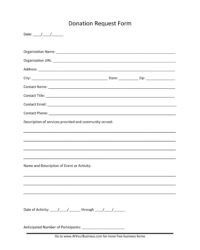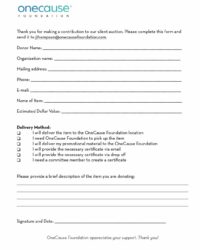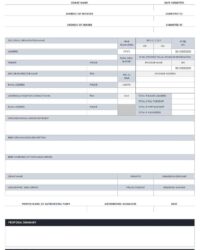Utilizing such a form offers several advantages. It saves time and effort for both the applicant and the donor, promoting efficiency and transparency in the donation process. Furthermore, a well-crafted application increases the likelihood of securing funding by presenting a professional and organized request. This can be particularly beneficial for smaller organizations or those lacking dedicated grant writing resources.
The subsequent sections will delve into the specific components of a well-structured application, offering practical advice on crafting compelling narratives and presenting financial information effectively. Examples and best practices will be provided to guide users through the process of creating successful funding requests.
Key Components of a Donation Application
Effective donation applications share several key components that contribute to their clarity and persuasiveness. These elements ensure potential donors receive the necessary information to evaluate the request and make informed decisions.
1. Executive Summary: A concise overview of the organization and the project requiring funding, highlighting the project’s impact and the requested amount.
2. Organizational Background: A description of the organization’s mission, history, and accomplishments, establishing credibility and demonstrating expertise in the relevant field.
3. Need Statement: A clear articulation of the problem or opportunity being addressed, emphasizing the importance of the project and its potential impact on beneficiaries.
4. Project Description: A detailed explanation of the proposed project, including objectives, activities, timelines, and expected outcomes. This section should clearly outline how donated funds will be utilized.
5. Budget: A comprehensive breakdown of project costs, demonstrating responsible financial planning and transparency in resource allocation. A clear budget builds trust with potential donors.
6. Evaluation Plan: A description of how project success will be measured and reported, providing accountability and demonstrating a commitment to achieving tangible results.
7. Sustainability Plan (Optional): An outline of how the project will continue to operate beyond the initial funding period, showcasing long-term vision and impact.
8. Contact Information: Clear and accessible contact information for follow-up questions or further discussion, facilitating communication and building relationships with potential donors.
These components, when combined effectively, create a compelling narrative that showcases the value and impact of the proposed project. A well-structured application increases the likelihood of securing funding and building strong donor relationships.
How to Create a Donation Application Template
Creating a standardized donation application template ensures consistency and professionalism in fundraising efforts. A well-designed template facilitates efficient processing of requests and provides potential donors with the necessary information to make informed decisions. The following steps outline the process of developing a comprehensive and effective template.
1. Define Purpose and Scope: Clearly outline the types of projects or initiatives the template will be used for. This ensures the template remains relevant to specific funding needs.
2. Structure the Template: Organize the template into logical sections, including an executive summary, organizational background, need statement, project description, budget, evaluation plan, sustainability plan (if applicable), and contact information. This structured approach enhances clarity and readability.
3. Develop Clear Instructions: Provide concise and unambiguous instructions for completing each section of the template. This guidance minimizes potential confusion and ensures complete submissions.
4. Incorporate Prompts and Examples: Include specific prompts and examples within each section to guide applicants and ensure they provide the necessary details. Illustrative examples clarify expectations and promote consistency.
5. Design for Accessibility: Format the template for easy navigation and readability. Consider using clear headings, bullet points, and sufficient white space to enhance visual appeal and accessibility.
6. Test and Refine: Pilot test the template with potential applicants and gather feedback. Revise and refine the template based on feedback to ensure its effectiveness and user-friendliness.
7. Disseminate and Train: Distribute the finalized template to relevant stakeholders and provide training on its use. This ensures consistent application and maximizes the template’s impact.
A well-designed template simplifies the application process, promotes transparency, and enhances the likelihood of securing funding. Consistent use of a standardized template strengthens fundraising efforts and builds stronger donor relationships.
Standardized forms for soliciting funding represent a crucial tool for organizations seeking financial support. A well-crafted application, encompassing a clear articulation of need, detailed project descriptions, and transparent budget breakdowns, enhances the likelihood of securing funding. Streamlined processes benefit both applicants and potential donors through increased efficiency and clarity. Developing a comprehensive template incorporating key components and clear instructions empowers organizations to present compelling cases for support, fostering stronger donor relationships.
Ultimately, the effective utilization of these resources can significantly impact an organization’s ability to achieve its mission and create positive change. Investing time and effort in developing and implementing robust application procedures positions organizations for long-term success in securing the necessary resources to fulfill their objectives.


